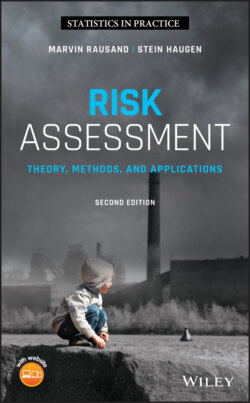Читать книгу Risk Assessment - Marvin Rausand - Страница 2
Table of Contents
Оглавление1 Cover
2 Dedication
3 Preface What is Changed From the First Edition? Supplementary Information on the Internet Intended Audience Selection of Methods Reference
4 Acknowledgments
5 About the Companion Site
6 Chapter 1: Introduction 1.1 Risk in Our Modern Society 1.2 Important Trends 1.3 Major Accidents 1.4 History of Risk Assessment 1.5 Applications of Risk Assessment 1.6 Objectives, Scope, and Delimitation 1.7 Problems References Note
7 Chapter 2: The Words of Risk Analysis 2.1 Introduction 2.2 Risk 2.3 What Can Go Wrong? 2.4 What is the Likelihood? 2.5 What are the Consequences? 2.6 Additional Terms 2.7 Problems References
8 Chapter 3: Main Elements of Risk Assessment 3.1 Introduction 3.2 Risk Assessment Process 3.3 Risk Assessment Report 3.4 Risk Assessment in Safety Legislation 3.5 Validity and Quality Aspects of a Risk Assessment 3.6 Problems References Note
9 Chapter 4: Study Object and Limitations 4.1 Introduction 4.2 Study Object 4.3 Operating Context 4.4 System Modeling and Analysis 4.5 Complexity 4.6 Problems References
10 Chapter 5: Risk Acceptance 5.1 Introduction 5.2 Risk Acceptance Criteria 5.3 Approaches to Establishing Risk Acceptance Criteria 5.4 Risk Acceptance Criteria for Other Assets than Humans 5.5 Closure 5.6 Problems References Note
11 Chapter 6: Measuring Risk 6.1 Introduction 6.2 Risk Metrics 6.3 Measuring Risk to People 6.4 Risk Matrices 6.5 Reduction in Life Expectancy 6.6 Choice and Use of Risk Metrics 6.7 Risk Metrics for Other Assets 6.8 Problems References
12 Chapter 7: Risk Management 7.1 Introduction 7.2 Scope, Context, and Criteria 7.3 Risk Assessment 7.4 Risk Treatment 7.5 Communication and Consultation 7.6 Monitoring and Review 7.7 Recording and Reporting 7.8 Stakeholders 7.9 Risk and Decision‐Making 7.10 Safety Legislation 7.11 Problems References Note
13 Chapter 8: Accident Models 8.1 Introduction 8.2 Accident Classification 8.3 Accident Investigation 8.4 Accident Causation 8.5 Accident Models 8.6 Energy and Barrier Models 8.7 Sequential Accident Models 8.8 Epidemiological Accident Models 8.9 Event Causation and Sequencing Models 8.10 Systemic Accident Models 8.11 Combining Accident Models 8.12 Problems References
14 Chapter 9: Data for Risk Analysis 9.1 Types of Data 9.2 Quality and Applicability of Data 9.3 Data Sources 9.4 Expert Judgment 9.5 Data Dossier 9.6 Problems References
15 Chapter 10: Hazard Identification 10.1 Introduction 10.2 Checklist Methods 10.3 Preliminary Hazard Analysis 10.4 Job Safety Analysis 10.5 FMECA 10.6 HAZOP 10.7 STPA 10.8 SWIFT 10.9 Comparing Semiquantitative Methods 10.10 Master Logic Diagram 10.11 Change Analysis 10.12 Hazard Log 10.13 Problems References
16 Chapter 11: Causal and Frequency Analysis 11.1 Introduction 11.2 Cause and Effect Diagram Analysis 11.3 Fault Tree Analysis 11.4 Bayesian Networks 11.5 Markov Methods 11.6 Problems References
17 Chapter 12: Development of Accident Scenarios 12.1 Introduction 12.2 Event Tree Analysis 12.3 Event Sequence Diagrams 12.4 Cause–Consequence Analysis 12.5 Hybrid Causal Logic 12.6 Escalation Problems 12.7 Consequence Models 12.8 Problems References Note
18 Chapter 13: Dependent Failures and Events 13.1 Introduction 13.2 Dependent Failures and Events 13.3 Dependency in Accident Scenarios 13.4 Cascading Failures 13.5 Common‐Cause Failures 13.6 β‐Factor Model 13.7 Binomial Failure Rate Model 13.8 Multiple Greek Letter Model 13.9 α‐Factor Model 13.10 Multiple ‐Factor Model 13.11 Problems References
19 Chapter 14: Barriers and Barrier Analysis 14.1 Introduction 14.2 Barriers and Barrier Classification 14.3 Barrier Management 14.4 Barrier Properties 14.5 Safety‐Instrumented Systems 14.6 Hazard–Barrier Matrices 14.7 Safety Barrier Diagrams 14.8 Bow‐Tie Diagrams 14.9 Energy Flow/Barrier Analysis 14.10 Layer of Protection Analysis 14.11 Barrier and Operational Risk Analysis 14.12 Systematic Identification and Evaluation of Risk Reduction Measures 14.13 Problems References
20 Chapter 15: Human Reliability Analysis 15.1 Introduction 15.2 Task Analysis 15.3 Human Error Identification 15.4 HRA Methods 15.5 Problems References
21 Chapter 16: Risk Analysis and Management for Operation 16.1 Introduction 16.2 Decisions About Risk 16.3 Aspects of Risk to Consider 16.4 Risk Indicators 16.5 Risk Modeling 16.6 Operational Risk Analysis – Updating the QRA 16.7 MIRMAP 16.8 Problems References
22 Chapter 17: Security Assessment 17.1 Introduction 17.2 Main Elements of Security Assessment 17.3 Industrial Control and Safety Systems 17.4 Security Assessment 17.5 Security Assessment Methods 17.6 Application Areas 17.7 Problems References
23 Chapter 18: Life Cycle Use of Risk Analysis 18.1 Introduction 18.2 Phases in the Life Cycle 18.3 Comments Applicable to all Phases 18.4 Feasibility and Concept Selection 18.5 Preliminary Design 18.6 Detailed Design and Construction 18.7 Operation and Maintenance 18.8 Major Modifications 18.9 Decommissioning and Removal 18.10 Problems References
24 Chapter 19: Uncertainty and Sensitivity Analysis 19.1 Introduction 19.2 Uncertainty 19.3 Categories of Uncertainty 19.4 Contributors to Uncertainty 19.5 Uncertainty Propagation 19.6 Sensitivity Analysis 19.7 Problems References
25 Chapter 20: Development and Applications of Risk Assessment 20.1 Introduction 20.2 Defense and Defense Industry 20.3 Nuclear Power Industry 20.4 Process Industry 20.5 Offshore Oil and Gas Industry 20.6 Space Industry 20.7 Aviation 20.8 Railway Transport 20.9 Marine Transport 20.10 Machinery Systems 20.11 Food Safety 20.12 Other Application Areas 20.13 Closure References
26 Appendix A Elements of Probability Theory A.1 Introduction A.2 Outcomes and Events A.3 Probability A.4 Random Variables A.5 Some Specific Distributions A.6 Point and Interval Estimation A.7 Bayesian Approach A.8 Probability of Frequency Approach References Note
27 Acronyms
28 Author Index
29 Subject Index
30 WILEY SERIES IN STATISTICS IN PRACTICE
31 End User License Agreement
